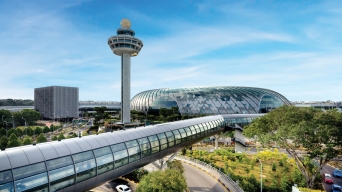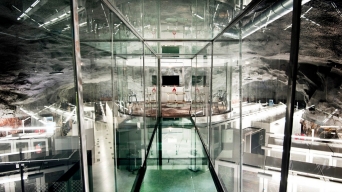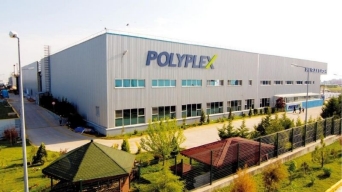Heat from a distance
Heat Pumps, Denmark
Heating is essential in a cold, Danish winter. But burning gas or oil to create it harms the environment. Systems from Aktive Energi Anlæg A/S with heat pumps from EVAPCO offer a clean alternative. Using ambient air, they generate district heat for entire small cities, which benefits both people and nature.
It is a November morning in Asaa, a village in the northeast of Denmark. It is -5 degrees Celsius outside and a cold wind blows around the pedestrians’ ears. But, in a single-family home around the corner, it is nice and warm: the heating system provides a cozy warmth. Residents in Asaa heat their homes with a clear conscience, because their heating system is climate neutral. The heat is produced using green electricity in the city’s new central district heating system with help from a heat pump. The heat is generated centrally and then distributed to houses via insulated underground pipes. From there, it arrives in the single-family home’s heating system.
The system was designed by the engineering firm Aktive Energi Anlæg A/S (AEA) together with the refrigeration expert EVAPCO and ebm‑papst. It is suitable for villages with as few as 100 houses to small cities with 50,000 inhabitants. AEA organized all of the suppliers and coordinated the project with the local plant operator. EVAPCO supplied the heat pump system and ebm‑papst the fans. The three companies joined forces because they suddenly saw a new demand in the market.
Tim Thøgersen, Sales Engineer at EVAPCO, explains, “Until then, there were only small heat pumps for single-family houses or gigantic plants for big cities. But when the Danish government promoted district heating, there was suddenly a great deal of interest in medium-sized heat pumps for power stations that generate heat for small communities. Yet, there was no product available for this.”
A reverse dry cooler
Until then, EVAPCO in Denmark mainly produced customer-specific dry coolers for district heating plants or solar plants. Using fans, these dry coolers dissipate waste heat — in hot water, thermal oil or steam — into the ambient air. The manufacturer has been working with ebm‑papst for 15 years. The company developed heat pumps for the first time for the project in Asaa. Thøgersen says, “In principle, heat pumps are simple reverse dry coolers. A dry cooler cools water down, a heat pump heats water up. Therefore, our main task was to use calculations to find the right design so that everything would work the way it was supposed to.”
"It is not unusual for district heating systems to be in the middle of a city. This means that the EC fans have to be quiet." - Tim Thøgersen, Sales Engineer at EVAPCO
A district heating system consists of an air/water heat pump with 2.5 megawatts combined with seven energy absorbers. The energy absorbers contain EC axial fans that draw energy from the air and convey it into the system. EVAPCO fluctuated between two suppliers when choosing the fan manufacturer. In the end, ebm‑papst’s service gave it the edge: “The support we received from the Danish office was extraordinary,” says Thøgersen. “As soon as we get an order, everything has to happen quickly. We have to give the energy suppliers an answer on the same day. ebm‑papst always answered our inquiries within a few hours. They also had much shorter delivery times than its competitor.”
What is district heating?
District heating is generated in a central power or heating plant. An own heating system is is not necessary. An underground pipe system conducts the heat into the house. (Graphic | Statista)
Please work quietly
The noise level of the EC fans also played an important role in selecting the partner. Thøgersen explains: “It is not unusual for district heating systems to be in the middle of a city, right next to residential buildings. Of course, this means that the EC fans have to be quiet. In this case we have the possibility to use FlowGrids on our AxiBlade fans. They reduce the noise level by two dB(A).” Tim Thøgersen also sees the controllability of the EC fans as another advantage. It is easy to turn the fans down when there are lower heating requirements. This improves the system’s efficiency and also decreases the noise.
There are around 80 AxiBlade EC fans in this district heating system and they gather ambient heat in every season. Torben Kirkolt, Managing Director of ebm‑papst in Denmark, says: “Even if the air is -10 degrees Celsius, it still contains energy.”
However, in the pilot project, minus temperatures sometimes caused difficulties for the fans as they iced up. ebm‑papst was able to remedy this with new software settings. Kirkolt explains, “We have now set the parameters so that the fans are always moving. Even if they are not being used, they simply shake the ice off.” The "FanSet" app from ebm‑papst helped them to adapt. Torben Kirkolt and his colleagues were able to activate the parameters easily via MODBUS. He explains, “You simply put your mobile phone onto the fan and press a button. The app then uploads the new information.” This means that it is no longer necessary to take the fans apart and install new wires. The app from ebm‑papst is available for all customers worldwide.
Seven energy absorbers in the district heating plant in Asaa absorb energy from the air. (Photo | EVAPCO)
6,000 fewer metric tons of CO₂
After the plant in Asaa, another two local heating systems were set up by AEA, EVAPCO and ebm‑papst in 2020. They are located in the villages Vig, with almost 3,000 inhabitants, and Højby, with 1,450 inhabitants, in the northwest of the country. But the three companies are sure that this was just the beginning. In June 2020, the Danish government decided to completely phase out crude oil and natural gas as heat sources in the Christiansborg climate agreement with the aim of reducing the country’s CO₂ emissions. It is increasingly relying on district heating.
Today, district heating covers 60 percent of the final energy requirement in Denmark. To compare, the figure is only 14 percent in Germany. Data from the Vig and Højby plants show the positive effects that this is having on the climate. Together, they save around 6,000 metric tons of CO₂ per year compared to when natural gas was the heat source. In any case, the companies are ready to jump into action when any new orders come in. Tim Thøgersen sums up, “Now we have a solid concept that we can reuse at any time. We just have to calculate how many energy absorbers the solution requires and we are ready to go.”
District heating market in Europe
Denmark comes after Iceland in second place in supplying its inhabitants with district heating. (Graphic | Statista)


